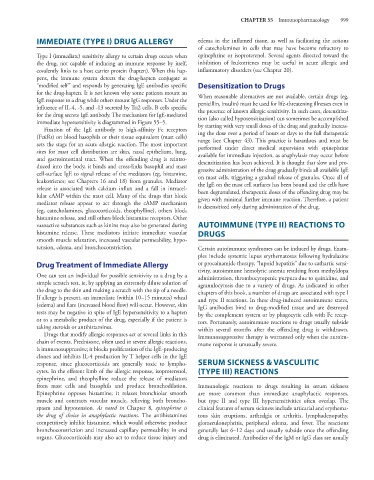Page 1013 - Basic _ Clinical Pharmacology ( PDFDrive )
P. 1013
CHAPTER 55 Immunopharmacology 999
IMMEDIATE (TYPE I) DRUG ALLERGY edema in the inflamed tissue, as well as facilitating the actions
of catecholamines in cells that may have become refractory to
Type I (immediate) sensitivity allergy to certain drugs occurs when epinephrine or isoproterenol. Several agents directed toward the
the drug, not capable of inducing an immune response by itself, inhibition of leukotrienes may be useful in acute allergic and
covalently links to a host carrier protein (hapten). When this hap- inflammatory disorders (see Chapter 20).
pens, the immune system detects the drug-hapten conjugate as
“modified self” and responds by generating IgE antibodies specific Desensitization to Drugs
for the drug-hapten. It is not known why some patients mount an When reasonable alternatives are not available, certain drugs (eg,
IgE response to a drug while others mount IgG responses. Under the penicillin, insulin) must be used for life-threatening illnesses even in
influence of IL-4, -5, and -13 secreted by Th2 cells, B cells specific the presence of known allergic sensitivity. In such cases, desensitiza-
for the drug secrete IgE antibody. The mechanism for IgE-mediated tion (also called hyposensitization) can sometimes be accomplished
immediate hypersensitivity is diagrammed in Figure 55–5. by starting with very small doses of the drug and gradually increas-
Fixation of the IgE antibody to high-affinity Fc receptors
(FcεRs) on blood basophils or their tissue equivalent (mast cells) ing the dose over a period of hours or days to the full therapeutic
range (see Chapter 43). This practice is hazardous and must be
sets the stage for an acute allergic reaction. The most important performed under direct medical supervision with epinephrine
sites for mast cell distribution are skin, nasal epithelium, lung, available for immediate injection, as anaphylaxis may occur before
and gastrointestinal tract. When the offending drug is reintro- desensitization has been achieved. It is thought that slow and pro-
duced into the body, it binds and cross-links basophil and mast gressive administration of the drug gradually binds all available IgE
cell-surface IgE to signal release of the mediators (eg, histamine, on mast cells, triggering a gradual release of granules. Once all of
leukotrienes; see Chapters 16 and 18) from granules. Mediator the IgE on the mast cell surfaces has been bound and the cells have
release is associated with calcium influx and a fall in intracel- been degranulated, therapeutic doses of the offending drug may be
lular cAMP within the mast cell. Many of the drugs that block given with minimal further immune reaction. Therefore, a patient
mediator release appear to act through the cAMP mechanism is desensitized only during administration of the drug.
(eg, catecholamines, glucocorticoids, theophylline), others block
histamine release, and still others block histamine receptors. Other
vasoactive substances such as kinins may also be generated during AUTOIMMUNE (TYPE II) REACTIONS TO
histamine release. These mediators initiate immediate vascular DRUGS
smooth muscle relaxation, increased vascular permeability, hypo-
tension, edema, and bronchoconstriction. Certain autoimmune syndromes can be induced by drugs. Exam-
ples include systemic lupus erythematosus following hydralazine
Drug Treatment of Immediate Allergy or procainamide therapy, “lupoid hepatitis” due to cathartic sensi-
tivity, autoimmune hemolytic anemia resulting from methyldopa
One can test an individual for possible sensitivity to a drug by a administration, thrombocytopenic purpura due to quinidine, and
simple scratch test, ie, by applying an extremely dilute solution of agranulocytosis due to a variety of drugs. As indicated in other
the drug to the skin and making a scratch with the tip of a needle. chapters of this book, a number of drugs are associated with type I
If allergy is present, an immediate (within 10–15 minutes) wheal and type II reactions. In these drug-induced autoimmune states,
(edema) and flare (increased blood flow) will occur. However, skin IgG antibodies bind to drug-modified tissue and are destroyed
tests may be negative in spite of IgE hypersensitivity to a hapten by the complement system or by phagocytic cells with Fc recep-
or to a metabolic product of the drug, especially if the patient is tors. Fortunately, autoimmune reactions to drugs usually subside
taking steroids or antihistamines. within several months after the offending drug is withdrawn.
Drugs that modify allergic responses act at several links in this Immunosuppressive therapy is warranted only when the autoim-
chain of events. Prednisone, often used in severe allergic reactions, mune response is unusually severe.
is immunosuppressive; it blocks proliferation of the IgE-producing
clones and inhibits IL-4 production by T helper cells in the IgE
response, since glucocorticoids are generally toxic to lympho- SERUM SICKNESS & VASCULITIC
cytes. In the efferent limb of the allergic response, isoproterenol, (TYPE III) REACTIONS
epinephrine, and theophylline reduce the release of mediators
from mast cells and basophils and produce bronchodilation. Immunologic reactions to drugs resulting in serum sickness
Epinephrine opposes histamine; it relaxes bronchiolar smooth are more common than immediate anaphylactic responses,
muscle and contracts vascular muscle, relieving both broncho- but type II and type III hypersensitivities often overlap. The
spasm and hypotension. As noted in Chapter 8, epinephrine is clinical features of serum sickness include urticarial and erythema-
the drug of choice in anaphylactic reactions. The antihistamines tous skin eruptions, arthralgia or arthritis, lymphadenopathy,
competitively inhibit histamine, which would otherwise produce glomerulonephritis, peripheral edema, and fever. The reactions
bronchoconstriction and increased capillary permeability in end generally last 6–12 days and usually subside once the offending
organs. Glucocorticoids may also act to reduce tissue injury and drug is eliminated. Antibodies of the IgM or IgG class are usually

